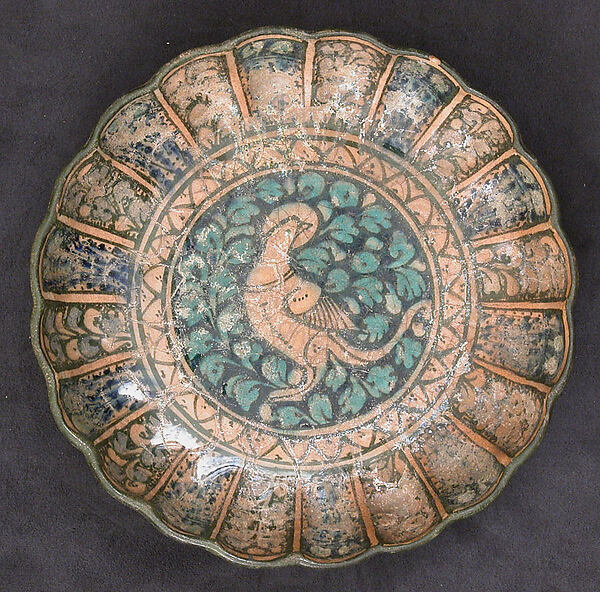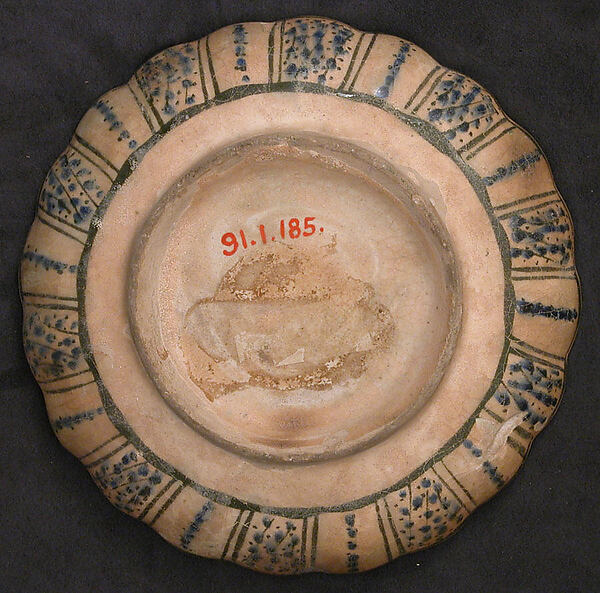I do believe I'm at plate nine now. I'm a bit late in posting this one, It's been out of the kiln for two weeks but in my excuse, your honour, is that I've been away on a field trip with the JMSS students to look at Volcanoes in Western Victoria. What could beat volcanos, scoria cones, the 12 apostles and all sorts of funky wildlife? No, not much, especially when you're being paid to examine these things!
So anyway...
So anyway...
This plate is a little bit different from previous plates. Since experimenting with shading and dark-on-light and light-on-dark colour mixing I've been wanting to use the wavy bisque plates again. So I spent alot of time searching the Ashmolean and the Victoria and Albert and the Met Museums. They all have rather good search engines and very varied and beautiful collections. It is sometimes a bit frustraiting trying to find that perfect reference you remember seeing though, so I also suggest getting a Pinterest account.
I found the perfect extant piece for my experiment, no only does it have wavy edges, it also uses alot of green, a colour I've been meaning to experiment with for a while. This dish (figure 1) is from Iran, 14th century. The dish appears to be molded into a wavy, flat bowl shape. Though not a plate, I thought the imagery would convert nicely.
Figure 1: Extant dish from Iran, 14th Century. Beautiful greens and blues. Met Museum, accession number 91.1.185. It was acquired by the museum in 1891.
There are a couple of tricky things on this plate. The first
being the solid background of vegetation behind the dove. On past plates
I've had trouble with small white gaps appearing when I join two
colours. There are three possible causes for this; I don't paint to the
edge (pre-school mistake), I overlap the glaze, making it too thick and
it pops off in the firing process, or the greylead underneath some
shapes causes the glaze not to stick making it shed during firing. The
easy solution to two of these uses the information from the drollery
plates. I know that to make shading one must place dark on light. So I
painted the light leaves first and then filled in the background with
dark pigment hoping it would bake over the light pigment and fix cause
number one. If cause number two was the case, all my leaves would now
have a pretty white outline and I'd learn something new. For cause
number three, I decided to risk using an eraser to ensure the greylead
was as light as possible and I used pencil sparingly.
Problem
number two is the pale blue shading in the border. At times it looks
like water colour. This has to result from a single application of glaze
which can be hard to apply to large areas. The original also has floral
stems in every second edge panel. To ensure the appropriate painting of
blue, I painted the stems, then covered the panel with the single layer
of blue shading. Pre-firing (figure 2) it didn't look to good but I
was hopefully the drollery experiement result will win though again.
Figure 2: The dove plate pre-firing. The blue decorations on the sides look quite blobby and really detract from the clean lines of the center of the plate.
The firing was a success and I am very pleased with how this plate came out.
Figure 3: Front of extant plate
|
Figure 4: Back of extant plate, a simplier floral plattern has been used to decorate the edge of the plate.
|
Figure 5: Front of my copy. As this is a plate not a dish, the edge plaques aren't as long and elegant but I still thing the overall design is balanced.
|
Figure 6: The back of my copy. I've replicated the edge decorations using black rather than dark green.
|
Summary: Success - no mystery white lines. Drollery experiments have showed their worth. I love the green colour.






